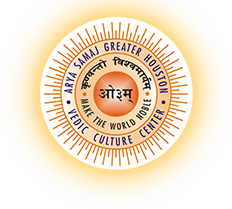Vedic Agnihotra
Agni-hotra is an integral part of the Vedic Heritage. Literally, Agni-hotra is the sacrificial fire, which is of three kinds: Gaarhapatya, Aahavaniya and Dakshina. The Vedas stand for the true knowledge, both physical and transcendental. The Vedic teachings are based on the intuition of the man, who meditated upon the Truth or Absolute to know what Paramaatman, Jivatman and Prakriti mean. Therefore the Vedas are said to be the guideline for Dharma, Artha, Kaama and Moksha, which can be attained through Purushartha and Praarabhdha. Purushartha stands for the actions based on morality, ethics and religious obligations.
In other words, Purushartha is based upon human actions associated with the will power. Praarabhdha is the fruits of our actions, which we are destined to have as a result of the actions we do in daily life. Every action corresponds to its fruit, i.e. equal and opposite reaction. Therefore, if we long for the serene life from today, we must go in for right actions, right deeds and right thoughts. The Agni-hotra is a way, which leads us to attain the highest. That highest is the attainment of Ishwara -- to realize the Divinity in and around, both immanent and transcendent.
Agni-hotra has its spiritual and materialistic values. It elevates our Spirit, lifts us from physical understanding to the blissful state of mind. It is a step by step approach to reach the highest dawn, from man to Rishi. It is the very concept of sat-chit-anand, or Truth, Consciousness and Bliss.
Etymologically, if we analyze the word Agni, it is the combination of A (aa), G (ga), N (na), and I (ee). A stands for the Immutable Lord Parmeshwara. Akaar is Vishnu, which pervades everywhere. It is the Primal sound -- the sound that travels in the Universe, which is the very cause of existence. G or ga means what goes -- the movement. The movement is the vibration which is present in the Universe. N or na means the integral universe and I represents compassion, wonder and to obtain. So,Agni,is to give us, what we need for a meaningful life. Agni is therefore the closeness of man with nature. It is to offer everything to Ishwara, who is none else but the Supreme Force of creation, preservation and dissolution.
To put our oblations, which belong to Agni, Soma, Prajapati, Indra etc. in the physical Agni, is Agni-hotra. It is the action or will to do. It is linked with samidha -- the fuel got from the jungles, the ignition, samagri, Vedi/Kunda, jalam -- water, shrucha -- the spoon. What is needed is the knowledge of the four directions, as well. Agni-hotra involves geography associated with forestry, agronomy, oceanography, and metallurgy. Above all, the knowledge of Sanskrit is essential to know its meaning, so that we could commune with the WORD and its meaning.
The Agni-hotra stands for the integration of human resources with the spiritual knowledge. Agni is both physical and spiritual. Therefore, we must promote the concept of Agni-hotra, while reciting the Vedic Mantras. Agni-hotra is of social value. It gives us the basic concept of Samaj -- the highest values governing the Vedic ethos, tradition and teaching. Swami Dayanand has referred to the Agnihotra in his famous work "Satyarth Prakash".
